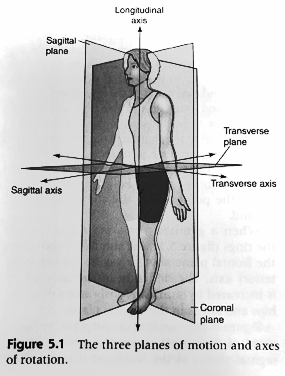Main Purpose: To convey the importance of controlling the positioning of the body segments relative to one another and intentionally/habitually assuming the best postures to enable the neuro-muscular and skeletal systems to function and achieve performance requirements.
Key Points:
-
Biomechanical principles
-
Planes of motion
-
Length-tension relationship
-
Force-velocity relationship
-
-
Posture
-
Definition
-
Key muscle groups
-
Joint positioning
-
-
Posture in 3D Movement
-
Lever systems
-
Center of pressure
-
Anyone who I have worked with me knows what a stickler I am for technique, particularly when it comes to appropriate joint alignment throughout the movement skill. So OF COURSE I jumped at the opportunity to blog about Chapter 5: Importance of Posture in Athletic Movement! It is fantastic that Clive dedicated an entire chapter just to the importance of posture; he makes it very clear what good posture is and looks like, and relates it back to the basic exercise principles that most of us coach from. This post will be in a slightly different order than the chapter, but I promise to keep it short and sweet!
Before we talk about posture, it’s important to understand the basic bio-mechanical principles that are codependent with posture: the planes of motion, length-tension relationships, and force-velocity relationships. I have included Clive’s image of the planes of motion. The planes bisect the body at 90 degrees to one another, and the axes meet at the center of mass, and are the points about which rotation occurs. Fitness professionals need to be aware of two things: 1. Motions can be defined based on what plane they are in (parallel to), and 2. Most sport movements occur in multiple planes at once. More on this in a bit.

3 planes of motion
Length-tension relationships of muscles are simpler; basically, each muscle has an ideal resting length that will produce the maximum amount of tension when contracted. So, if the muscle is already in a shortened position when an athlete flexes, less force will be produced than if the muscle had been in its ideal position. This also applies if the muscle is in a longer position than is ideal. Force and velocity have an inverse relationship during concentric muscular contraction and a direct relationship during eccentric contraction. More importantly, the force-velocity relationship is a determinant in muscular recruitment, which impacts performance.
Okay, I am so excited for this part: the definition of (good) posture: “that state of muscular and skeletal balance that protects the supporting structures of the body against injury or progressive deformity, irrespective of the attitude (erect, lying, squatting, or stooping) in which the muscles are working or resting. Under such conditions, the muscles will function most efficiently and the thoracic and abdominal organs are in their optimum positions.” (For the full definition, see page 88). Highlighted here is the importance of postural integrity and relative positioning of the joints. Joint alignment is critical in movement; where the joints are in relation to one another determines the efficiency of the musculoskeletal system. This can be the difference between maxing a squat at 275 lb and 290 lb.
What is your typical advice for improving posture? Core strength, perhaps? Here’s the thing: abdominal muscle groups are NOT the only muscles involved in proper posture. Let’s think about the definition of posture above. What muscle groups are required to produce and maintain proper alignment of the joints within the trunk of the body? Abdominals, spinal erectors…AND hip flexors and extensors. Whoa, our athletes need to work on glutes, quads, and hamstrings in addition to core to have good posture?! INDEED! Most of us have heard of the kinetic chain. When applied to the concept of posture, it makes sense. Our muscles overlap and are connected in some ways, so tightness in one group causes compensation in another leading to less efficient movement patterns.
It is not enough to simply do leg curls, crunches, or step ups to increase the strength of these vital postural groups. Remember what I mentioned earlier? Motion occurs in multiple planes of motion. I.E. performance involving dynamic movements requires dynamic movements in training. Some thought needs to be put into the exercises we give our athletes, especially pertaining to two factors: the human lever system and the center of pressure. There are three types of lever systems that differ based on the order of the Effort, Fulcrum, and Resistant force. My biomechanics instructor taught us the acronym EFR-FRE-FER to remember the first, second, and third lever class systems. Different joints and associated movements involve different lever systems, and it is important to address that multi-joint movements involved multiple levers acting at once and interacting with one another. Manipulating variables such as the length of the lever arm of the resistant force can help to engage the appropriate muscle groups at their ideal positions and lengths. The center of pressure is the concept that relates to posture and ground-reactive forces. Training athletes to distribute weight appropriately in different body positions and movements will help create efficient movement and prevent injury.
I apologize if I babbled a bit, I could have written paragraphs on paragraphs about this topic! Thank you, Clive, for presenting the importance of postural integrity and relating it to the other aspects of training that we as coaches most emphasize. Please comment with any questions or add-ons, and stay tuned for postural assessments!
What do you think about the Athletic Movement Skills Series? Could you add a comment or question for Coach Blaser below? Our team of bloggers would like to know your feedback. When you submit a comment our goal is to post it within 24 hours. Thanks for your feedback!
“The views, opinions, and judgments expressed in this message are solely those of the authors and peer reviewers. This content has been reviewed by a team of contributors but not approved by any other outside entity including the Roman Catholic Diocese of Raleigh.”


